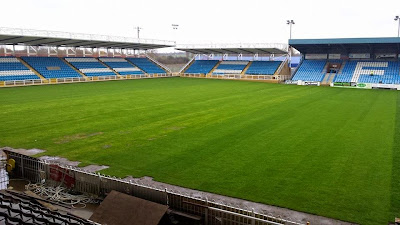Throughout our long and proud history Featherstone
Rovers have been justifiably well-known for producing outstanding local talent,
and less well-known for big money signings. However, when large transfer fees
started to become the fashion in the 1980s, Rovers were not afraid to ‘splash
the cash’.
 |
| Graham Steadman |
Graham Steadman was certainly one of those big money signings,
as the club smashed its transfer-fee record to bring him to Featherstone for £55,000.
Ironically he was also an outstanding local talent, but after occasionally
playing for Rovers Under 17s side, a brief trial at Bradford that didn’t work
out and even a spot of rugby union at Knottingley, he eventually turned
professional for York. He enjoyed five outstanding seasons there and when he arrived
at Post Office Road it was with a great sense of expectation that he would
finally solve the problem of a fixed half-back partner for Great Britain
international scrum-half Deryck Fox. Fox had previously played with Alan
Banks and Andy Mackintosh.
At York, Steadman had basically been their only
attacking weapon and everything went through him. At Featherstone, exactly how
to use his obvious pace, tremendous sidestep and acceleration was more
problematic. He also had an excellent short and long range kicking game which
needed to be dovetailed with the work of Fox as main tactical kicker. Successive
coaches struggled to harness Graham’s mercurial talents into our team pattern. Neither
George Pieniazek nor Paul Daley ever managed to resolve this conundrum. Rovers
even turned at one stage to veteran stand-off Johnny Crossley, shifting
Steadman to the three quarters, which was a waste of his ability.
When Peter Fox arrived, he immediately switched Steadman
to full-back for the first time. However, this experiment lasted just two
matches and the rest of his Featherstone career was at stand-off. This was understandable
as Rovers had the excellent Chris Bibb at full-back, but it was a shame that
the idea was cut short. Years later Daryl Van Der Velde tried the same thing
and, with more patience and coaching, Steadman rapidly became a prolific try
scoring phenomenon at full-back and was Great Britain’s number one choice in
that position for a number of seasons.
After twelve tries in his first year and seventeen
the following year as Rovers won promotion from the Second Division, Steadman
started the 1988/89 season in outstanding fashion. Combining perfectly with Fox,
he scored 14 tries and looked a much more potent attacking threat. This form
only made his end of season transfer to our local rivals all the more
unfortunate. The acrimonious nature of his departure to Castleford in the
summer of 1989 somewhat overshadowed the fact that he served Rovers well for
three seasons and that the club had made a handsome profit too. He played 96
games for Featherstone and scored 48 tries.
After retiring he coached at Castleford, and then,
oddly enough for a player who was exciting with ball in hand but not as strong a
tackler, he plied his trade in international rugby union as a defensive coach.
He is a member of the Hall of Fame at both York and Castleford.

No comments:
Post a Comment